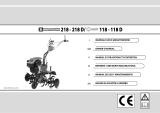
11
5 6
Deutsch
SICHERHEITSVORKERUNGEN
VORSICHT: Vibrationen, die beim Betrieb von
benzinbetriebenen Handgeräten auftreten, können bei
Personen, die zu Durchblutungsstörungen oder abnormen
Schwellungen neigen, zu Schädigungen von Blutgefäßen
und Nerven, Händen und Handgelenken führen. Auch bei
Gesunden können bei längerem Gebrauch in kalter
Witterung Schädigungen von Blutgefäßen auftreten. Wenn
Symptome wie Taubheit, Schmerzen, Kraftverlust,
Veränderungen der Hautfarbe oder -struktur oder
Empfindungsverlust in Fingern, Händen oder
Handgelenken auftreten, arbeiten Sie nicht mehr mit
diesem Gerät und suchen Sie einen Arzt auf.
ACHTUNG - Bei richtiger Anwendung ist die motorhacke ein
schnelles, bequemes und wirkungsvolles Arbeitsgerät; falls
Sie sie falsch oder ohne die nötige Vorsicht einsetzen, kann
sie zu einer Gefahr werden. Beachten Sie bitte daher
unbedingt die Sicherheitsvorschriften die Sie nachstehend
in der Betriebsanleitung finden, damit ihre Arbeit immer
angenehm und sicher ist.
ACHTUNG: Das Zündsystem Ihres Geräts erzeugt ein
elektromagnetisches Feld geringer Stärke. Dieses Feld kann
unter Umständen Herzschrittmacher beeinflussen. Um die
Gefahr ernster oder gar tödlicher Unfälle zu reduzieren,
sollten Personen mit Herzschrittmachern vor Benutzung
dieser Maschine ihren Arzt und den Hersteller des
Herzschrittmachers zu Rate ziehen.
ACHTUNG! – Nationale Verordnungen können den
Gebrauch des Geräts einschränken.
1 - Lesen Sie dieses Handbuch sorgfältig, bis Sie alle
Sicherheitsvorschriften, Vorsichtsmaßnahmen und
Bedienungsanweisungen vollständig verstanden haben und
befolgen können, bevor Sie mit dem Gerät arbeiten.
2 - Die Verwendung des Motorhacke darf nur Erwachsenen erlaubt
werden, die die Sicherheitsvorschriften, Vorsichtsmaßnahmen
und Bedienungsanweisungen in diesem Handbuch verstanden
haben und befolgen können. Minderjährige dürfen niemals mit
einem Motorhacke arbeiten.
3 - Arbeiten Sie niemals mit einem Motorhacke, wenn Sie müde,
krank oder aufgeregt sind oder unter Einfluss von Alkohol,
Drogen oder Medikamenten stehen. Sie müssen sich in guter
körperlicher Verfassung befinden und geistig frisch sein.
Arbeiten mit einem Motorhacke ist anstrengend. Wenn Sie sich
in einer Verfassung befinden, die durch anstrengende Arbeit
verschlimmert werden könnte, wenden Sie sich an einen Arzt,
bevor Sie mit einem Motorhacke arbeiten (Abb.1) Seien Sie vor
Ruhezeiten und gegen Ende Ihrer Schicht besonders vorsichtig.
4 - Kinder, Umstehende und Tiere müssen mindestens 15 m
Sicherheitsabstand zum Arbeitsbereich halten. Halten Sie
andere Personen oder Tiere beim Starten und Gebrauch des
Motorhacke in einem ausreichenden Sicherheitsabstand
(Abb.2).
5 - Tragen Sie beim Arbeiten mit dem Motorhacke stets
zugelassene Schutzkleidung. Tragen Sie keine Kleider, Schals,
Halstücher oder Armbänder, die sich in Zweigen verfangen
können. Binden Sie langes Haar hoch und bedecken Sie es
(zum Beispiel mit einem Tuch, einer Kappe, einem Helm
usw.) Sicherheitsschuhe mit rutschfester Sohle und
durchtrittsicherer Einlage. Tragen Sie eine Schutzbrille oder
einen Gesichtsschutz. Verwenden Sie einen Lärmschutz wie
zum Beispiel, einen Kapselgehörschutz oder Ohrstöpsel.
Tragen Sie Handschuhe, mit denen Vibrationen möglichst
gut gedämpft werden (Abb.3-4-5-6).
6 - Lassen Sie nur Personen mit diesem Motorhacke arbeiten,
die dieses Bedienungshandbuch gelesen haben oder
entsprechende Anweisungen für den sicheren und
ordnungsgemäßen Betrieb dieses Motorhacke erhalten haben.
7 - Prüfen Sie den Motorhacke täglich, um zu überprüfen, ob alle
Vorrichtungen hinsichtlich der Sicherheit oder in sonstiger
Hinsicht einwandfrei arbeiten.
8 - Arbeiten Sie niemals mit einem beschädigten, veränderten
oder nicht sachgemäß reparierten oder zusammengebauten
Motorhacke. Entfernen Sie keine Sicherheitsvorrichtungen
und beschädigen oder deaktivieren Sie sie nicht. Ersetzen
Sie Schneidwerkzeuge und Sicherheitsvorrichtungen sofort,
die beschädigt oder gebrochen sind oder in sonstiger Weise
entfernt wurden.
9 - Planen Sie die Arbeitsweise sorgfältig im Voraus. Sorgen Sie
vor Beginn der Arbeit dafür, dass sich im Arbeitsbereich keine
Hindernisse befinden. Achten Sie auf sicheren Stand.
10 - Wartungsarbeiten am Motorhacke mit Ausnahme der in
diesem Handbuch dargestellten Verrichtungen dürfen nur von
Fachpersonal durchgeführt werden.
11 - Die Motorhacke ist ausschließlich zum Zerkleinern und Lockern
des Bodens ausgelegt. Es wird davon abgeraten, andere
Materialien zu schneiden. Jede andere, nicht in dieser Anleitung
ausgewiesene Verwendungsart kann Schäden an der Maschine
verursachen und Personen sowie Sachen ernsthaft gefährden.
12 - An die Motorhacke dürfen ausschließlich Arbeitsgeräte und
Zubehör lt. Herstellerspezifikationen angeschlossen werden.
13 - Benutzen Sie die Maschine niemals ohne das Schutzgehäuse
der Drehwerkzeuge.
14 - Der Bediener ist dafür verantwortlich, die potenziellen
Gefahren bei der Bearbeitung des Bodens abzuwägen und in
diesem Sinne, besonders in Hanglage und auf unwegsamem,
rutschigem oder lockerem Gelände, sämtliche Vorkehrungen
zur Gewährleistung der eigenen Sicherheit zu treffen.
15 - Im Gefälle müssen Sie besonders vorsichtig und stets quer zum
Hang arbeiten, niemals auf- bzw. abwärts. Verwenden Sie die
Motorhacke nicht auf Böden mit einem Gefälle über 10° (17 %).
16 - Der Besitzer bzw. Bediener ist in jedem Fall für die Unfälle oder
Risiken gegenüber Dritten oder deren Besitz verantwortlich.
17 - Vergewissern Sie sich beim Einschalten der Fräswerkzeuge, dass
sich niemand vor oder im nahen Umfeld der Maschine befindet.
Beim Anlaufen der Fräswerkzeuge sollten Sie den Lenkholm fest
umklammern.
18 - Halten Sie sich bei der Arbeit in einem Sicherheitsabstand zu
den Fräswerkzeugen auf; dieser Abstand entspricht der Länge
des Lenkholms.
19 - Beim Einsatz auf abschüssigem Gelände muss der Bediener
darauf achten, dass sich niemand in einem Umkreis von
20 Metern zur Maschine aufhält. Der Bediener darf die
Steuerungen auf keinen Fall verlassen.
20 - Die Maschine kann mit verschiedenem Zubehör ausgerüstet
werden. Der Besitzer ist dafür verantwortlich, die Zulassung
von Arbeitsgeräten oder Zubehör nach den einschlägigen
europäischen Sicherheitsvorschriften nachzuweisen. Der Einsatz
nicht zugelassenen Zubehörs kann Ihre Sicherheit gefährden.
21 - Sämtliche Schilder mit den Gefahrensymbolen und
Sicherheitszeichen müssen sich in einwandfreiem Zustand
befinden. Bei Beschädigung oder Unleserlichkeit müssen sie
rechtzeitig ersetzt werden (siehe Seite 6-7).
22 - Das Gerät darf ausschließlich für die in der Betriebsanleitung
angegebenen Zwecke verwendet werden (siehe seite 33).
23 - Halten Sie die Betriebsanleitung stets griffbereit. Fordern Sie bei
Verlust der Betriebsanleitung eine Kopie derselben an.
VORSICHT: Benutzen Sie niemals eine Maschine mit
fehlerhafter Sicherheitsausstattung. Die
Sicherheitsausstattung der Maschine muss wie in diesem
Abschnitt beschrieben überprüft und gewartet werden.
Wenn Ihre Maschine eine dieser Prüfungen nicht besteht,
wenden Sie sich an den Kundendienst, um sie reparieren zu
lassen.





















